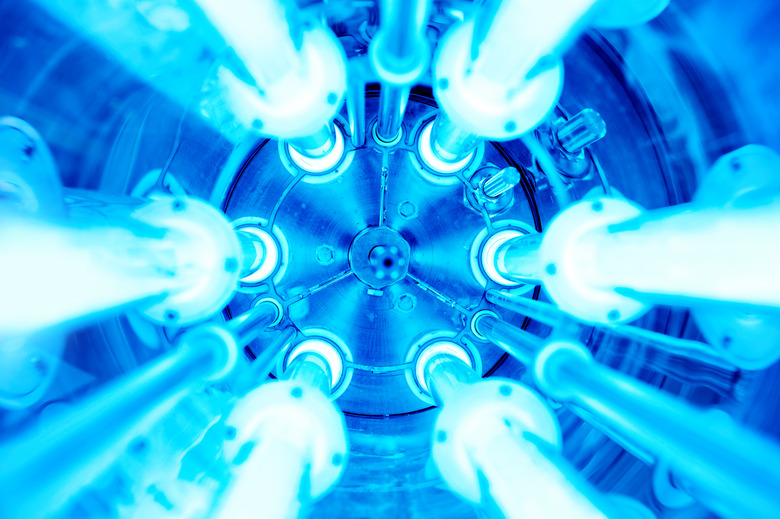How To Kill Mold Spores With UV Light
We may receive a commission on purchases made from links.
It's true that ultraviolet light can kill mold spores, but it's not quite as simple as zapping a moldy wall with a UV lamp. Most household UV lamps don't generate enough exposure to kill mold. Even when they do, it's of note that dead mold spores can still aggravate allergies and asthma. If you have a mold issue you want to treat with ultraviolet light, it's important to understand all the ins and outs of this process.
What Is UVGI?
What Is UVGI?
Ultraviolet light is scientifically proven to effectively kill bacteria, viruses, and mold. The process of doing so is known as ultraviolet germicidal irradiation (UVGI), and it's often used in hospitals to prevent the spread of bacteria. Many HVAC installers also recommend installing a UVGI inside ductwork to keep mold from growing in the HVAC system and spreading through your house. Some household water filtration systems also use ultraviolet light to kill bacteria and other contaminants in the water.
The ultraviolet light used in UVGI lamps is the same as that found in sunlight. It kills mold and other bacteria by penetrating the organism's cells and damaging the DNA within. This prevents the cell from reproducing, and it will simply die off rather than spreading or perpetuating itself. The process works well and has been used in disinfectant applications for more than 140 years.
Drawbacks of UVGI
Drawbacks of UVGI
As effective as UVGI may be, it's not a practical mold solution all the time for several reasons. The first is that the light must come in direct contact with the mold spores in order to kill them. This makes it possible to kill mold spores in the air and on solid surfaces. The light may not penetrate deeply enough, however, to kill mold spores safely tucked away in porous surfaces, like drywall.
Cost is also a concern. A permanently installed UVGI system that can handle an entire room costs an average of about $9,000. As a homeowner, you can get a much smaller portable lamp for around $100, but these do only a small area at a time. A 15-watt lamp, for example, treats approximately 100 square feet. If you have a major mold remediation issue to fix, a small lamp might prove impractical and incredibly time-consuming.
Note too that ultraviolet light is potentially dangerous. Even an artificial light source, like a UV lamp, can cause a sunburn. It's also important to protect your eyes from UV light. Fortunately, many UV lights for home use have built-in motion detectors that turn the light off if they detect the movement of people or pets.
How to Use UVGI
How to Use UVGI
UVGI systems are best reserved for HVAC and water filtration purposes. If you have a small patch of mold you wish to treat with UVGI, be sure to do so properly. Strap on your UV-protectant goggles and then position your UV lamp so that it shines directly on the mold. Turn on the lamp and turn off all the other lights in the room. Close any curtains or blinds as well.
Leave the light on for about two hours. Then, go back to the room and reposition the lamp so it hits the mold from a different angle. Let it shine for another two hours. You'll need to repeat this process for every place in your home where you have mold.
Remember that dead mold spores can still trigger health issues. Run an air filtration system or purifier in the room where you're killing mold to try to trap the dead mold spores and dispose of them. Otherwise, the mold could still present a danger to sensitive members of your household.
Other Mold Removal Methods
Other Mold Removal Methods
If you're cleaning up mold after a flood or a leak, you may find more conventional mold removal techniques to be faster and more effective than UVGI treatment. Start by throwing away any furniture, carpet, insulation, or other porous materials that got moldy. A mold remediation specialist or restoration service may be able to save these items for you if they're sentimental in nature, but porous surfaces typically don't fully recover from mold problems.
To get rid of the mold that remains, spray undiluted white vinegar directly on the mold and let it sit for an hour. (Don't apply vinegar to wood or stone countertops.) If the mold doesn't wipe away easily, mix 1 teaspoon of baking soda to 2 cups of water in a spray bottle. Spray the baking soda on the mold and then scrub the area with a stiff brush. After a good scrubbing, rinse the area with warm water and then allow it to dry completely.
When it has dried, spray the area again with undiluted vinegar. This time, allow the vinegar to dry naturally rather than rinsing it away. This will let the vinegar work on any remaining mold spores and help prevent regrowth.
References
- United States Environmental Protection Agency: Does Ultraviolet (UV) Radiation From UV Lamps Kill Mold?
- ServiceMaster Restore: Will Bleach or Vinegar Kill Mold?
- American Ultraviolet: Frequently Asked Questions
- Home Inspector Secrets: Does UV Light Kill Mold? (2021 Ultimate Guide)
- Costimates: How Much Does a UVGI Air Purification System Cost?
